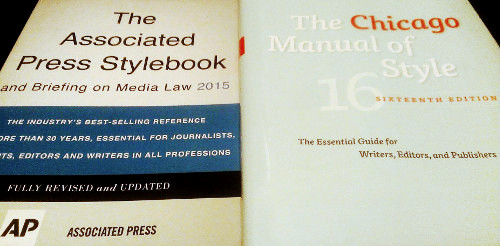In the US, there are two style guides for professional writing and editing that reign supreme. In one corner, we have the Chicago Manual of Style (CMS), currently in its sixteenth edition and beloved most in the arena of book publishing. In the other corner, we have the Associated Press Stylebook (AP), the most widely used guide for news writing. The primary functions of each guide seem, at first glance, to be different enough to ensure that any animosity generated over their discrepancies are relatively minimal. But if you’re an editor who deals with both or a reader who doesn’t understand the inconsistencies between the sorts of things you read, the tension can be palpable.
Whether we should or shouldn’t, we all have pet rules that we push to mercilessly enforce. Perhaps one of the best-known sources of conflict is over the serial comma, also referred to as the Oxford comma. This comma is placed between the last two items of a list, before a conjunction, and is used in CMS. I personally support the serial comma in all instances because, while it might not be necessary every single time, it promotes consistency and makes the reader’s experience more predictable (and therefore easier). Others assert that it should be omitted where possible to reduce unnecessary punctuation (which is AP’s position), and still others feel that arguments such as these are pointlessly divisive and don’t do much to strengthen language anyway.
There are other differences that are significantly less contentious, though. It makes sense for newspapers to do what they can to save space, so the fact that AP recommends taking out the middle spaces in an ellipsis isn’t likely to ruffle the devout CMS-user’s feathers. Similarly, AP’s use of numerals for numbers higher than nine isn’t unreasonable at all, and though that’s not CMS’s default, it actually does give you that option if you need it. While there are enough discrepancies to build a website out of, plenty of each guide is either in line with the other or so clearly geared toward their different respective audiences that there’s no chance to get into an argument in the first place.
In book publishing, CMS is the one you really, really need to know, and because I got into editing with an eye specifically for books (and because, in my opinion, CMS is just much more comprehensive and makes more sense), that’s the one I prefer. However, I also do contract copyediting for the Portland State Vanguard, and apart from a couple pages of house style, AP is what I use there. Who knows—maybe news editing is where I’ll end up long-term if that’s where I find work. I’d be sad to only get to dust off CMS for my own writing, but it’s not as though working in a different style guide is some sort of tragedy. It’s actually fine.
Ultimately, these questions that we as editors get so worked up over, the questions that divide families, tear friendships to ribbons, and separate lovers (maybe), are merely questions of style. And as an editor, it pays to respect whichever style you’re expected to use at any given time. Refusing to dig into more than one guide on the basis of preference is professionally limiting, and there’s really no reason to limit the number of ways you can make a living as an editor if you don’t have to.

